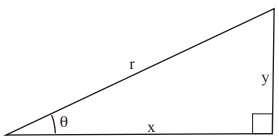Assignment:
1. Estimate your volume. Make clear any assumptions you make in this calculation, and explain how you get your answer.
2. The diameter of a regulation basketball is 9.51 inches.
(a) What is the volume of a regulation basketball, in cubic meters?
(b) Convert your answer from part (a) to cubic centimeters.
3. The mass of a regulation basketball is approximately 22 ounces. What is the average density of a basketball, in kg/m3?
4. To order of magnitude, estimate the number of cars in Chico. Justify your answer.
5. Solve for x, without using any electronic devices. 3x2 + 7x = 6
6. Given the triangle shown below, find an equation for:
(a) x in terms of y and r.
(b) x in terms of r and θ.
(c) x in terms of y and θ .
(d) θ in terms of y and r.

7. If ƒ(x) = 1/2x3 + sin(ax2) e-bx, what is d/dx f(x)?
8. You biked 5.00 miles to a friend's party at the other side of town at 15.0 mph. When you got there, you suddenly remembered that you had not yet finished your physics homework that would be due at 8am Monday, so you dashed home at 25.0 mph. What was your average speed for the whole trip?
9. I was recently approached by a wild-eyed gentleman who tried explaining to me that the c in Einstein's equation E = mc2 was "center of mass" (measured in units of length) rather than the speed of light. Given that the units of energy E are kg m2/s2 , comment on whether this
interpretation of E = mc2 could possibly be correct.
10. Most of the homework sets in this class will have a problem that requires use of a computer to solve. The Python programming language is the recommended tool for these problems. You will need an up-to-date version of Python on your computer, as well as a couple additional libraries that add extra mathematical functionality to Python. Go to the "Python" link on the course webpage, click "Problem 1" and install these tools on your computer. Test your installation by following the "Test your installation" instructions on that page.
Once things are working, make a plot of cos(t) with 20 t points ranging from 0 to 2*pi. Plot those 20 points using red circles. Put your name in the title. Label the x axis "theta" and the y axis "cos(theta)". Don't panic if your printer won't print out the red circles in color; but at least figure out how to make them red on your computer screen.